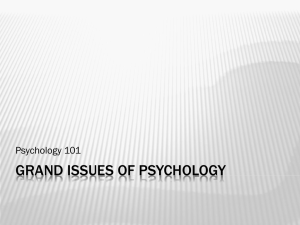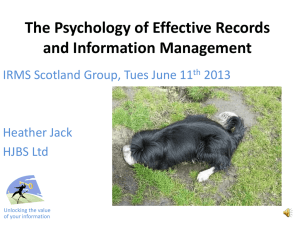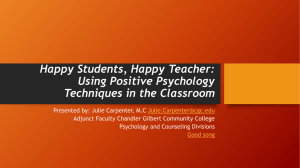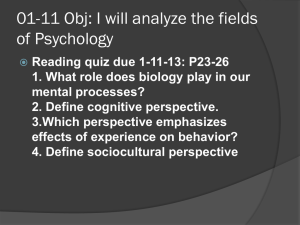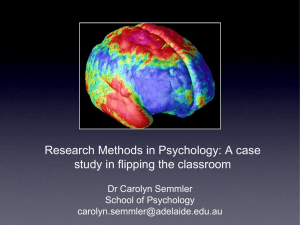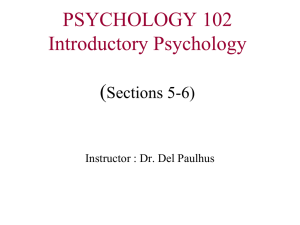Postgraduate Conference Programme 2013
advertisement
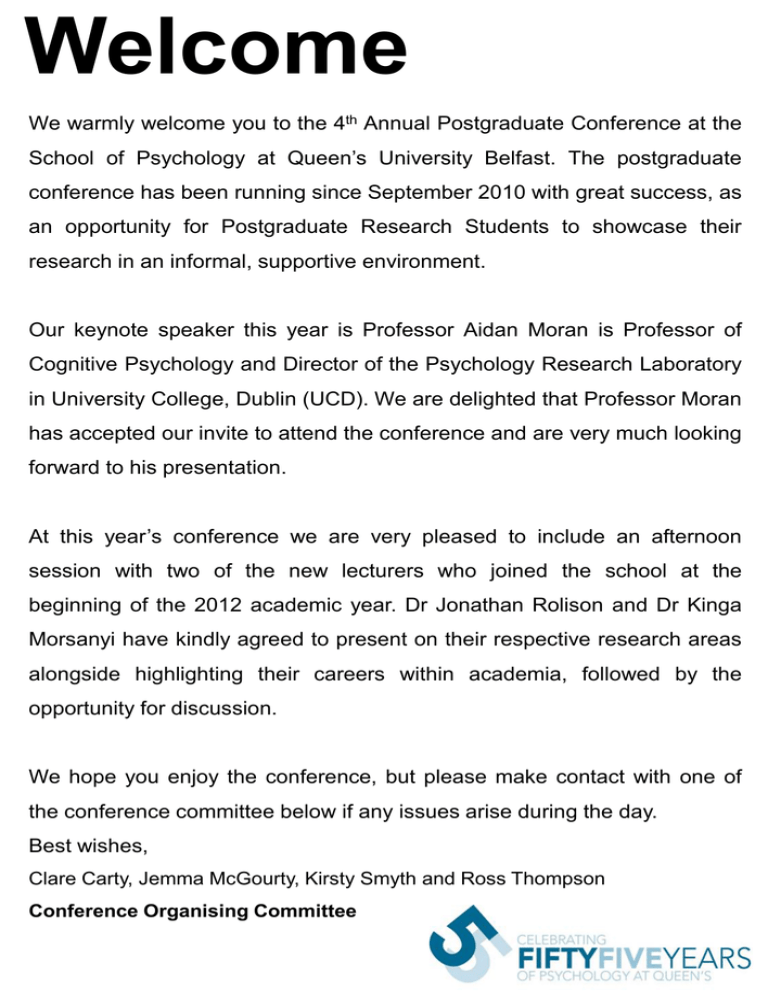
Welcome We warmly welcome you to the 4th Annual Postgraduate Conference at the School of Psychology at Queen’s University Belfast. The postgraduate conference has been running since September 2010 with great success, as an opportunity for Postgraduate Research Students to showcase their research in an informal, supportive environment. Our keynote speaker this year is Professor Aidan Moran is Professor of Cognitive Psychology and Director of the Psychology Research Laboratory in University College, Dublin (UCD). We are delighted that Professor Moran has accepted our invite to attend the conference and are very much looking forward to his presentation. At this year’s conference we are very pleased to include an afternoon session with two of the new lecturers who joined the school at the beginning of the 2012 academic year. Dr Jonathan Rolison and Dr Kinga Morsanyi have kindly agreed to present on their respective research areas alongside highlighting their careers within academia, followed by the opportunity for discussion. We hope you enjoy the conference, but please make contact with one of the conference committee below if any issues arise during the day. Best wishes, Clare Carty, Jemma McGourty, Kirsty Smyth and Ross Thompson Conference Organising Committee Acknowledgements We would like to express our sincere gratitude towards: Our keynote speaker, Prof Aidan Moran Dr Jonathan Rolison, Dr Kinga Morsanyi The postgraduate students presenting The School of Psychology, Queen’s University Belfast and the Postgraduate Centre, Queen’s University Belfast for their generous sponsorship Conference Organising Committee Clare Carty Jemma McGourty Kirsty Smyth Ross Thompson 09:45 – 10:00 Registration, Tea and Coffee 10:00 – 10:10 Dr Clifford Stevenson 10:10 – 10:30 Welcome from Postgraduate Tutor Claire McAroe, PhD Can fish learn place? Lee Beattie, PhD 10:30 – 10:50 Using adaptation to examine subsecond duration perception in the visual modality 10:50 – 11:10 Kevin Latimer, PhD 11:10 – 11:30 11:30 – 11:50 11:50 – 12:10 12:30 – 12:50 Mechanisms Underlying Time Perception Tea and Coffee Ciara Laverty, PhD Investigating the nature of auditory predictors of reading development: Maturation, Learning and Teaching Patrick Flack, PhD Identity Change amongst former members of loyalist paramilitary organisations Eoin Travers, PhD Motor dynamics of category-based reasoning under uncertainty Michelle O’ Loughlin, PhD 12:50 – 13:10 A Cognitive Approach to Designing Audio Description for the Visually Impaired 13:10 – 14:15 Lunch and Poster Presentations Prof. Aidan Moran, UCD 14:15 – 15:15 Imagination in Action: Mental Practice and Skilled Performance in Sport and Surgery 15:15 – 15:35 Dr Jonathan Rolison The Time Horizon of Risky Choice Dr Kinga Morsanyi 15:35 – 15:55 Mathematical anxiety reduces cognitive reflection: The road from discomfort in the mathematics classroom to susceptibility to biases 16:00 – 17:00 Wine Reception and Presentation of Prizes Keynote Speaker Prof Aidan Moran, Professor of Cognitive Psychology and director of the Psychology Research Laboratory in University College, Dublin Contact: aidan.moran@ucd.ie Profile Aidan Moran completed his undergraduate degree (1977) and Masters (1978) in Psychology at UCD and his PhD and training at the National University of Ireland, Galway (NUIG, 1984). He has held academic posts at NUIG and UCD, and has been Head of Department twice at UCD. He has written/co-written fifteen books and won awards for his extensive research in Cognition and Sport Psychology: e.g. Psychological Society of Ireland’s “Special Merit Award”, 2004, UCD President’s Research Fellowship Sabbatical, 2008-2009, for the project “Mental Practice, Eye-Movements and Cognition in Action” in collaboration with Imperial College, London, and Harvard University. In 2006, Prof Moran was made inaugural Editor-in-Chief of the “International Review of Sport and Exercise Psychology” (IRSEP, published by Taylor and Francis, Oxford), and has been an Official Psychologist to the Irish Olympic Squad. Keynote Speaker Research Interests Prof Moran’s research interests are in Cognitive and Sport Psychology. He has investigated motor cognition, looking at attentional and imagery processes underlying sports skills. Using an eye-tracker, Prof Moran’s research team has studied the cognitive and perceptual abilities that underlie how golfers judge the slope of putting surfaces, the distinctive kinematic features of successful putting, and the relationship between learning strategy and attentional focus in developing complex golf skills. In addition to this, Prof Moran has also researched how memory, visual search and the anticipation processes of martial arts experts differ from beginners. Also, he has researched how expert athletes differ from beginners in feeling-oriented imagery, and if auditory imagery processes can be measured using a real-world multi-sensory integration task. Information sourced from http://www.ucd.ie/psychology/staff/aidanmoran/ Oral Presentations Lee Beattie, School of Psychology, QUB Using adaptation to examine subsecond duration perception in visual modality Adaptation studies have suggested that subsecond event timing is encoded by distributed, modality-specific mechanisms (Buonomano & Karmarkar, 2002; Grondin 2010). Adaptation is a technique whereby extended viewing of a stimulus results in a perceived distortion (aftereffect) of a subsequently presented stimulus. Johnston, Arnold and Nishida (2006) demonstrated that it is possible to independently adapt a circumscribed area of the visual field using oscillating stimuli. This resulted in a reduced perceived duration of subsecond stimuli presented to the adapted region, but not elsewhere in the visual field. By exploiting this effect it is possible to infer the underlying neural mechanisms involved in the perception of brief intervals. This presentation will outline some of the methods currently in use to research subsecond time perception at Queen's. Patrick Flack, School of Psychology, QUB Identity change amongst former members of loyalist paramilitary organisations The aim of this project is to investigate the issue of identity change and, in particular, how collective continuity (e.g. Sani, 2008) and nostalgia (e.g. Wildschut et al, 2006) are employed to achieve this change. Psychologists have been interested in how certain groups deal with change and how it affects their identity (e.g. Jetten and Hutchison, 2010). Perfect examples of identity change are loyalist paramilitary organisations in Northern Ireland. Loyalist paramilitaries are still meaningful despite the cessation of violent conflict, highlighting the dramatic change in the functions these organisations perform. There has been little research carried out in the Northern Ireland context that has looked at issues such as identity change. The current project involves a series of in-depth interviews carried out with members of these organisations. The data I will present is based on this ongoing qualitative research project. Notably, I will focus on the dynamics of collective continuity and nostalgia in the process of identity re-construction Oral Presentations Kevin Latimer, School of Psychology, QUB Does direction-contingent duration compression following adaptation result from the function of retinotopically-tuned or spatiotopicallytuned neural mechanisms? Previous research has established that adaptating to a visual stimulus can result in the duration of a subsequent stimulus presented within the adapted region being underestimated (Johnston, Arnold & Nishida, 2006; Burr, Tozzi & Morrone, 2007). However there is still much debate as to whether this phenomenon is a retinotopically-based effect or spatiotopically-based effect. Recently Curran & Benton (2012) have provided evidence using unidirectional stimuli that such duration compression is direction-contingent. The present study aimed to establish whether this direction-contingent compression effect is retinotopically-based or spatiotopically-based using an experimental procedure that allowed the two conditions to be tested independently. Ciara Laverty, School of Psychology, QUB Investigating the nature of auditory predictors of reading development: Maturation, Learning and Teaching Reading is a complex skill which children must acquire in the early school years. The negative consequences of failure to make adequate progress in reading by the end of key stage one, highlights the importance of identifying early predictors of reading development in beginning readers. This project aims to examine the predictive validity of phonological skill, efficient phonics tuition, auditory learning and auditory maturation for subsequent reading development in typically developing children. Auditory learning has been assessed in study one through examining individual patterns of change in auditory discrimination thresholds over a 9 week learning period. Preliminary results show that auditory learning behaviour may be separated into three subgroups which demonstrate distinct learning patterns. Further studies will examine the predictive contributions of auditory maturation and phonics tuition to reading development, with a final study assessing whether an auditory predictor of reading may be used as a diagnostic indicator of reading difficulties. Oral Presentations Claire McAroe, School of Biological Sciences, QUB Can fish learn place? Cognitive Maps are thought to be complex neural representations of a familiar environment. Such maps allow for flexible and adaptive navigation through a previously encountered area. Due to their allowance for flexibility, they are thought to be more complicated strategies of navigation than simply learning a particular route or navigating using cues. A key feature of a cognitive map is alternative route planning- it allows the individual to successfully navigate to the same place irrespective of start point in the environment. Much of the research to date on cognitive mapping focuses on humans and other mammals such as rodents. What this research seeks to find is whether 4 different species of fish (Goldfish, Killifish, Zebrafish and Siamese Fighting Fish) can navigate to the same location in a maze to receive a food reward regardless of where the journey begins. Michelle O’ Loughlin, School of Modern Languages, QUB A cognitive approach to designing audio description for the visually impaired Audio description (AD) is an assistive method aimed at enabling blind individuals to enjoy audio-visual media by having visual elements of the media described during natural pauses in the audio. The current theory, paradigms and normal practices of AD have until recently been solely based on assumptions about the blind user. This project aims to contribute a cognitive approach to modify current AD practice and theory by firstly considering what is already known about the cognitive processing capacities of blind individuals, and secondly by experimentally examining how AD is experienced on a cognitive level by blind users. The findings of this project will hopefully take AD one step closer to applied solutions that can help to enhance the overall user-experience. Oral Presentations Eoin Travers, School of Psychology, QUB Motor dynamics of category-based reasoning under uncertainty Category-based reasoning allows us to go beyond what we know about the world and deal with novel situations and stimuli, by providing a mechanism of applying past experiences of category members to guide decisions about new instances. However, this kind of reasoning has been found in the past to be sub-optimal when categorization is uncertain, relying on the most likely category only, rather than considering multiple possible categories in a rational manner. The present research tests the hypothesis that implicit motor output, as measured by mouse movements in a reasoning task, is influenced by multiple categories in a way which explicit judgements are not. Oral Presentations Dr. John Rolison, School of Psychology, QUB The time horizon of risky choice Researchers interested in choice behavior have typically studied uncertainty (i.e., risky choice) and time horizon (i.e., preferential choice) in isolation. We demonstrate the importance of time horizon for risky choice by manipulating the time horizon of risky choice outcomes. Participants made hypothetical choices between a sure amount and a lottery gain or loss with the sure outcome, lottery outcome, both, or neither delayed. Time horizon exacerbated risk taking behavior when a delay was applied to the prospect of a loss, and heightened risk aversion when the prospect of a gain was delayed. Our discovery highlights a need to incorporate time horizon in studies of risky choice behavior and the potential for treating risky and preferential choice within a single theoretical framework. Dr. Kinga Morsanyi, School of Psychology, QUB Mathematical anxiety reduces cognitive reflection: The road from discomfort in the mathematics classroom to susceptibility in biases When asked to solve mathematical problems, some people experience anxiety and threat, which can lead to impaired mathematical performance (e.g., Ashcraft, 2002). The present studies investigated the effect of mathematical anxiety on performance on the cognitive reflection test (CRT; Frederick, 2005). The CRT is a measure of a person’s ability to resist intuitive response tendencies, and it correlates strongly with important real-life outcomes, such as time preferences, risk-taking, and rational thinking. Our experiments with university students (Experiment 1) and secondary school students (Experiment 2) demonstrated that mathematical anxiety was a significant predictor of cognitive reflection, even after controlling for the effects of general mathematical knowledge and test anxiety. Given earlier findings regarding the role of cognitive reflection in risky decision-making and rationality, these results suggest that the effects of mathematical anxiety extend beyond a negative impact on arithmetical performance and career opportunities. Posters Clare Carty, School of Psychology, QUB Social development and social functioning in typical development In the current study, eye-tracking techniques were used to explore the automaticity of looking to the eyes of faces and its relationship to social function in typical school aged children (N=99). In three separate conditions, participants were asked to freely view static images of faces, asked to avoid looking at the eyes, and also asked to avoid looking at the mouth. Social function was assessed with the Social Responsive Scale and the Social Competence Inventory. Inhibition ability was also assessed using two subtests from the Test of Everyday Attention for Children (TEA-Ch), as the task specifically asked the participants to inhibit a response. The findings revealed that the children could not completely avoid looking at the eyes when instructed, indicating that looking to eyes is not under volitional control. However, this automaticity of looking to the eyes was not related to social function. The implications of these findings will be discussed. Lisa Graham, School of Psychology, QUB Longitudinal study; Illness representations and psychological distress in Upper G.I. patients and carers This study aims to investigate the relationship between illness perceptions, coping mechanisms, and psychological distress (anxiety, depression, fear of recurrence) in Upper G.I cancer patients and their family carers. 131 patients with Upper G.I cancer being treated with curative intent and their family carers will be recruited from NHS oesophago-gastric surgery units and oncology wards across the UK. A baseline measure will be collected prior to treatment by survey, with follow-up measures after treatment, and at 2 and 4 month follow-up. Qualitative interviews will be conducted after the survey measures are complete. Regression analysis will be used to examine relationships between the different blocks of variables. Cluster analysis will be used to identify similar groups of patients. The results of this study will be used to develop a psychological intervention to reduce distress in this population. Posters Gerard Madden, School of Psychology, QUB Emotionally coloured discourse: Nonverbal behaviours as indicators of communication breakdown Human communication is an obvious example of emotional colouring in everyday life. Isolated channels of communication (such as text- or visualonly) raise interesting questions about the relative importance of different behaviours for expressing and recognising emotional states. Understanding the emotional quality of verbal and non-verbal behaviour is essential to the field of ‘affective computing’; the design of technologies that can recognise and respond appropriately to a user’s emotional state. The Sensitive Artificial Listener (SAL) is one such technology. SAL is an Avatar-dialogue system designed to interact with a user in a sustained, naturalistic way by attending to voice tone and non-verbal behaviour. Using SAL, this study investigated non-verbal behaviours that may act as signals of communication breakdown. Auditory feedback between the user and SAL was reduced to simulate a breakdown. Participants rated interactions favourably or unfavourably using interaction-quality measures. Reduction of auditory feedback had no effect on quality ratings, necessitating an alternative analysis. The nonverbal behaviours in the most-positively and most-negatively rated interactions were compared. Significant differences were found for the following behaviours; frowning (p = .029), ‘sad face’ (p < .001) and squinting (p < .001). Frowning and sad facial expressions can clearly communicate negative affect, but the context of squinting behaviour makes it difficult to determine if squinting definitively signals communication breakdown. However, previous research regarding the nature other non-verbal behaviours may make such conclusions possible. Posters Jemma McGourty, School of Psychology, QUB Do children value the future more than the past? Examining a bias in children’s episodic future thinking Adults tend to value the future more than the past, that is, display a temporal value asymmetry (Caruso, Gilbert and Wilson, 2008). As it is not yet known if children display this tendency in their episodic future thinking, a developmental consideration was made. A task was designed where participants heard either a past or future version of a hypothetical vignette and made a value judgment. 72 Undergraduate students (M = 21.13; SD = 6.54) participated in order for the validity of the task to be verified. Participants valued the future version of the vignette more than the past version, t = 2.869, df = 70, p = .005, thus participants displayed TVA. 321 children aged 9-16 years completed a child-friendly version of the task. There was no main effect of ‘event’ (past or future) on children’s valuations (F < 1) so these children did not display TVA. Theoretical considerations regarding the factors underlying TVA are discussed. Annie Melaugh McAteer, School of Psychology, QUB Alcohol attention bias in adolescents: An eye-tracking study Several theories suggest a key contributing role of alcohol attention bias (AAB) in the development of alcohol misuse and addiction. It has been reported in a variety of populations including alcohol dependant patients and adult social drinkers. Whilst the presence of AAB is confirmed by numerous studies, more detailed examinations of the nature of AAB have been beyond the scope of the methodologies employed. To date two studies have examined AAB in adolescent groups despite high levels of alcohol use in this population. Eye tracking provides a direct measure of attentional processing allowing us to examine the trajectory of AAB, providing new insights in the area. This study employs eye tracking in an adolescent population of social drinkers and non-drinkers to examine the presence and nature of AAB in this group. AAB is measured using a free viewing eye tracking paradigm alongside several questionnaires including Alcohol Use Disorders Identification Task, Alcohol Expectancy QuestionnaireAdolescent and Raven’s Advanced Matrices. Results indicate drinking groups show stronger attentional preference for alcohol stimuli compared to nondrinking groups. Details of developmental trajectory and relationship to alcohol use and alcohol expectancy will be discussed. Posters Kirsty Smyth, School of Psychology, QUB The inductive potential of religion categories for school-children in Northern Ireland Social inferences are generalisations people make about others based on the social categories they belong to. Often the most meaningful categories in a particular societal context are treated as the strongest basis for social inference. We examined children’s use of categories to make social generalisations across childhood, in different educational and national contexts. An inductive inference task was used to examine generalisations children make about whether two characters share an unfamiliar property, based on which social categories the two share, i.e. religion, gender, or a control category. We tested children aged 6-11 in integrated and segregated schools in NI, and state schools in America. We found that 6-7 year old children treat religion and the control category as equally strong bases for inference, while the older children treat religion as stronger than the control category. Gender was the weakest basis for inference at all ages, and by 1011 years children treat the control category as equal to gender in its usefulness as a basis for social inference. We also found an effect of educational context. At 10-11 years children in segregated schools in NI make more social inferences in general, than children attending NI integrated schools and state schools in the US. Children’s social inferences are an index that children hold essentialist beliefs about categories. Strong essentialist beliefs about social categories have been associated with stereotyping and prejudice; thus, research on the essentialisation of social categories has implications for combatting stereotyping and prejudice. Posters Patrick Stark, School of Psychology, QUB Phonological segmentation is unaffected by compression or expansion in poor readers: Evidence for the importance of temporal speech representations for reading The core cause of the reading difficulties experienced by some children is believed to relate to deficient phonological awareness. A number of researchers have proposed phonological awareness skills may be impaired as the result of an auditory processing deficit that impacts the processing of the spectratemporal structure of speech. While the segmentation ability of a group of 20 typical proficient readers was impaired after the compression of speech, both the poor readers (n=20) and the reading age-matched control group (n=20) were unaffected by the modifications. This suggests that typical readers depend on faster rate cues within speech for phonological awareness, compared with struggling readers who were unaffected by the degradation of fast rate acoustic changes. Ross Thompson, School of Psychology, QUB Factors affecting numeracy-related performance in undergraduate psychology students Numeracy-based quantitative methods are extremely important tools within the psychology discipline. Yet quantitative methods courses are generally perceived negatively by psychology undergraduates, many such students performing poorly in such courses. Numerous examples of previous research have posited factors that are feasibly responsible for these affective and performance-related deficits, yet few have attempted to explore large numbers of such variables within the framework of path analysis techniques. 118 1st year psychology undergraduates were tested on numeracy ability, maths anxiety, maths attitudes and various educational and demographic factors. A path analysis was then carried out on this data, with numeracy performance being the final endogenous variable. Results showed that a substantial minority of students tested had extremely strong levels of negative affect towards maths. Maths anxiety and previous educational qualifications were shown to be the strongest predictors of poor numeracy performance. Such results can help suggest potential interventions for improving negative affect and therefore performance.
